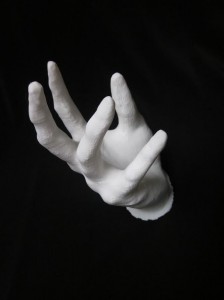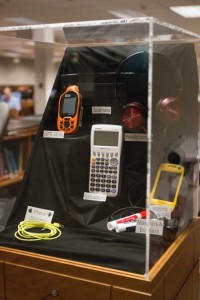[Best_Wordpress_Gallery id=”228″ gal_title=”3-D Printer”]
Megan Bird has seen Pokémon figures, fantasy board game pieces, MRI scans, chess sets, roses, and wedding cake toppers since she started working at the Harold B. Lee Library in Winter 2015. Bird works on the second floor Science and Maps section, where visitors can use the library’s 3-D printers to print essentially anything.
Bird hadn’t heard of 3-D printers before working there. “I think it’s way cool,” Bird said. “I think it’s kind of the nature of a 3-D printer that you get lots of (different things).”
Library patrons are looking for more than just books in the current digital era. But that doesn’t surprise librarians, and it doesn’t mean all libraries are dying. It just means they are adapting by adding different technologies, such as 3-D printers, for their communities’ needs.
National trends and desires for change
A 2013 Pew Internet survey on changing library usage found that “many library patrons are eager to see libraries’ digital services expand, yet also feel that print books remain important in the digital age.”
Fifty-two percent of recent library users interviewed survey said their library usage hasn’t changed in the past five years; 22 percent said their use has decreased; 26 percent said their usage increased.
Those whose usage increased cited various reasons:
- 26 percent enjoyed taking children to the library
- 14 percent used library research and reference materials
- 12 percent borrowed books
- 8 percent used library computers and internet
They also said they go more because the library is convenient in terms of time and costs. It has more diverse collections, media resources, and events and programs.
Some libraries across the country, according to the New York Times, are adding resources such as snowshoes, ukeleles and cake pans to their libraries. Utah County libraries, however, are making textbooks, books, e-books and technology more available to patrons.
The library as a community core
Provo City Library’s children’s services manager Joella Peterson has seen more people visit the library as digital resources become more prevalent in their lives and in the library’s collection.
Librarians are sharing information in all formats to stay a constant community resource. “Digital literacy is just as important as any other type of literacy,” Peterson said. Children expect adults to use technology, and it’s important for children to learn how a book works, she said.
Orem Public Library’s division manager over patron services, Mike Smith, said there is a common misunderstanding that everything is becoming digitized. “It’s heading toward that direction, with the end result becoming (a) more direct or easy way to access the information,” Smith said.
The Provo and Orem libraries are adapting their services to help patrons learn and interact at the library. They have computers and Wi-Fi. The Provo Library provides classes, including a monthly coding club for 8 to 12 year-olds, a Minecraft section for teens, and lab instructions for adults.
Patrons can also check out e-books and audio books on electronic devices using an app that automatically returns it to them. The book deletes itself from the patron’s app when it’s due. People can push a “return” button to return it when they are finished with the item.
A study room in the Provo Library lets adults hook up to a smart TV to see and toggle between different parts of multiple projects.
Smith said the Orem Library is looking to include maker spaces, or rooms with supplies to tinker with and make tangible products. Sewing projects, art supplies, dark rooms for developing photography and 3-D printers are also possible options. “The sky is the limit,” Smith said. The library is applying for grants for a mobile space to reach children in schools.
These physical city libraries close weekdays at 9 p.m. and Saturdays at 6 p.m., but their virtual doors never close. “Library usage, I feel, has almost gone up, because…online there’s 24-7 access for some of these resources,” Peterson said.
People who only come to the library to register for a card might not come for resources, but they often come for programs, such as story times, family home evening programs and book clubs. Book club members can watch authors’ YouTube video book presentations or Skype with authors. “It’s part of the library now,” Peterson said. “It’s not even a distinctive difference.”
Harold B. Lee Library working for student learning
Michael Whitchurch, virtual services and learning commons librarian at the Harold B. Lee Library, is one librarian always looking for ways to make the library a better learning space for students.
He noticed in 2004 that students weren’t using the general reference collection — which held encyclopedias, dictionaries, phone books and quotation books — but it took a few years to completely change it to the learning commons study area it is today.
Print resources still fill the library. The first floor auxiliary storage holds, among other things, government documents and pre-1990 periodicals. People who prefer these print versions can use them, but not many do. “There’s no reason for it to be out in a public space taking up space where we can put people when they can just be put away and accessed online,” Whitchurch said.

Some resources are “going from the paper to the electronic,” Whitchurch said, such as online subject and class guides and online databases. Students can ask librarians questions with chat systems, texting or emailing.
HBLL librarians are trying new ways to get items to students. When students request articles through interlibrary loan, a librarian scans the article and sends it to the student as an emailed attachment. Students can also request an item on the website to check out. A librarian will find it, check it out to the student, and have it ready for pickup at the circulation desk.
The library is also making efforts to reduce the cost of textbooks for students. Online open textbook resources allow students to even print the textbooks. “So you either buy it hard cover from the publisher for $70 to $80 or you can print it on demand for $25 or $30,” Whitchurch said. “We’re looking at all of those options.”
Several librarians have noticed needs beyond books and e-books. In May 2012, BYU librarians thought people should be able to use 3-D printers at a reasonable cost. Anyone could use the Crabtree Technology Building’s 3-D printers, “but the price put them beyond the use of many students,” said Jed Johnston, HBLL’s science reference specialist and software instruction manager.
The library bought a good, but not industrial grade, 3-D printer that month. “Once we knew IT and Science could support it, we purchased a much better machine,” Johnston said.

This summer they bought another, improved 3-D printer. “Because we didn’t have to pay back the large price tag of a professional printer, we could charge a rate that made the technology accessible to almost anyone” Johnston said. They are open to all in the library’s second floor science and maps section.
Students can also check out phone chargers, headphones, calculators, GPS systems, scanners and markers in the Science and Maps section.
Librarians also noticed people could use a video productions studio. Students can now reserve a room on the HBLL fourth floor to make videos. The room has recording and sound equipment, backgrounds and lighting.
“Librarians are very in tune to what’s going on in the departments and colleges on the campus,” Whitchurch said. “And we’re responding to that service.”
The HBLL is also reaching out to students with interactive programs. A Love Your Library week in February included a “blind date with a book” event and miniature golf course, “to try and get students in the library and learn about the library services while at the same time having fun,” Whitchurch said.
The HBLL has a YouTube channel to connect with students through fun videos about the library, book care and even audiobooks.
Adapting to the future
Smith said people ask about library’s future just as they have asked about radio’s and television’s futures. “The list goes on and on,” he said, “But they still exist.” Smith said he doesn’t feel the future of libraries is threatened.
“Libraries are an information portal,” he said. Even if electronic resources out-sell print resources, he said, librarians should be on top of that to provide information and stay relevant. “Libraries will always try to adapt and meet the needs of what people are accessing,” Smith said.




